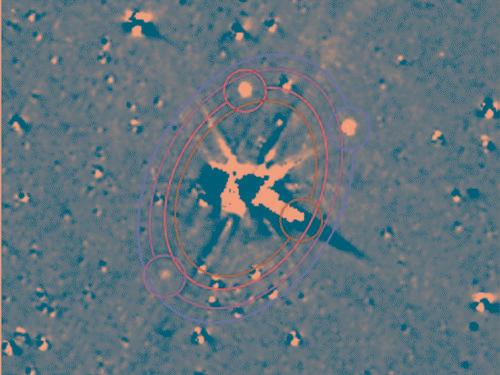
The Pluto family with the dwarf plant at the centre. The moon marked in green is Styx, yellow is Nix, orange is Kerberos, and red is Hydra. Photo: NASA.
WASHINGTON (PTI): NASA's New Horizons spacecraft has for the first time photographed Kerberos and Styx - the smallest and faintest of Pluto's five known moons, capturing its first-ever family portrait of the Pluto system.
New Horizons, which is speeding toward a historic flyby of Pluto on July 14, took the images detecting Kerberos and Styx with its most sensitive camera, the Long Range Reconnaissance Imager (LORRI), from April 25 to May 1.
Following the spacecraft's detection of Pluto's giant moon Charon in July 2013, and Pluto's smaller moons Hydra and Nix in July 2014 and January 2015, respectively, New Horizons is now within sight of all the known members of the Pluto system.
"New Horizons is now on the threshold of discovery," said mission science team member John Spencer, of the Southwest Research Institute in Boulder, Colorado.
"If the spacecraft observes any additional moons as we get closer to Pluto, they will be worlds that no one has seen before," he said.
Kerberos and Styx were discovered in 2011 and 2012, respectively, by New Horizons team members using the Hubble Space Telescope.
Styx, circling Pluto every 20 days between the orbits of Charon and Nix, is likely just approximately 7 to 21 kilometres in diameter, and Kerberos, orbiting between Nix and Hydra with a 32-day period, is just approximately 10 to 30 kilometres in diameter.
Each is 20 to 30 times fainter than Nix and Hydra.
"Detecting these tiny moons from a distance of more than 55 million miles is amazing, and a credit to the team that built our LORRI long-range camera and John Spencer's team of moon and ring hunters," said New Horizons Principal Investigator Alan Stern, of the Southwest Research Institute.
 Previous Article
Previous Article Next Article
Next Article













The Indian Air Force, in its flight trials evaluation report submitted before the Defence Ministry l..
view articleAn insight into the Medium Multi-Role Combat Aircraft competition...
view articleSky enthusiasts can now spot the International Space Station (ISS) commanded by Indian-American astr..
view article